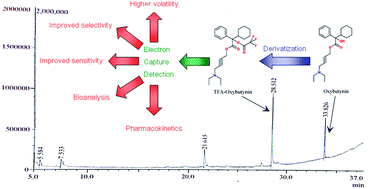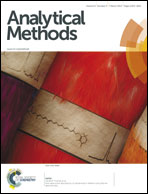Electron capture detection of oxybutynin in plasma: precolumn derivatization approach and application to a pharmacokinetic study†
Abstract
Oxybutynin is an antimuscarinic agent used for the treatment of an overactive bladder. Because of its poor chromophore, it is difficult to determine oxybutynin by HPLC-UV analysis The difficulty increases when the analysis involves a complex biological matrix like plasma. Precolumn derivatization with trifluoroacetic anhydride followed by GC separation and ECD was used to solve this problem. The developed GC-ECD method had good linearity in the concentration range 2–20 ng ml−1 with a correlation coefficient of 0.9959. The accuracy and sensitivity for the determination of the halogenated derivative by this method was better than that for GC–MS. NMR and mass spectroscopy data confirmed the derivatization reaction. The developed GC-ECD method was used to study the pharmacokinetic parameters of an oxybutynin transdermal patch (36 mg/39 cm2) and oxybutynin gel (10% w/w). The Cmax, Tmax and AUC0–96 values for the oxybutynin transdermal patch and oxybutynin gel were equivalent.


 Please wait while we load your content...
Please wait while we load your content...